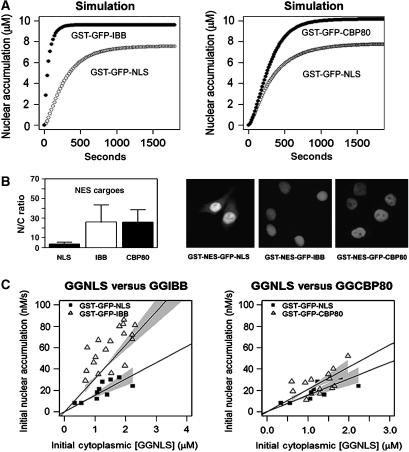Figure 2.
Comparison of import rates and steady-state nuclear accumulation for NLS, CBP80, and IBB protein cargoes. (A) Left panel: simulation results predict that cargo imported directly by Impβ has greater initial rate and steady-state level of nuclear accumulation than cargo imported via the Impα adapter. Right panel: the bipartite NLS, CPB80, is predicted to accumulate more efficiently than the monopartite NLS. (B) A total of 20 μM GST-NES-GFP-NLS, GST-GFP-NES-CBP80, or GST-NES-GFP-IBB was injected into HeLa cell cytoplasm. Confocal images were collected 30 min post-injection. N/C ratios were calculated from mean pixel intensities for the nuclear and cytoplasmic compartments. Values are means of 15 cells±1 s.d. (C) Experimental validation of the computer predictions. A portion of 20 μM cargo was injected into the cytoplasm of HeLa cells. Images were collected every 20 s. Pixel intensity was converted to concentration by use of an external series of standards. Initial rate was defined as the rate of change of nuclear concentration during the first 30 s. Initial concentration for each cell was plotted against initial rate and the slope was fit by linear regression. Each data point represents an individual cell. Gray areas indicate the 99% confidence interval of the regression line.

